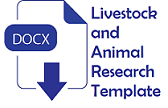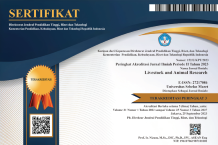Effect of feeding broilers with the diets containing leubim fish waste meals processed with including and without its skin on the weights and percentages of carcasses and internal organs of broilers
Abstract
Objective: This study aimed to evaluate the weights and percentages of carcasses and internal organs of broilers fed the partial substituted commercial ration (CCP) with leubim fish waste meal (LFW) made up of whole leubim fish waste meal (LFWW), leubim fish waste skin meal (LFWS), and skinless leubim fish meal (LFM‒S), each combined with yellow corn (YC) + top mix (TM).
Methods: 100 broiler chicks strain CP 707 and commercial local fish meal (CFM) were employed in this study. The study was performed into a Completely Randomized Design with subsampling comprising 5 treatments, 4 replications, and 2 subsamples. The treatment was 100% CCP (control+) and 16.5% of substituted feeds composted of the CFM (control-), the LFWW, the LFWS, the LFM‒S, with the same level of 8% each + 8% YC + 0.5% TM each. The data were analyzed by Analysis of Variance.
Results: Statistically, no significant differences (P>0.05) but substitute partial commercial diet with the mixture feeds constituted of LFW meals in the forms of LFWW, LFWS, LFW‒S, each added with YC + TM had relatively higher weights of whole carcasses and cut-ups of broilers. Relatively to life weight, the carcass percentages were equal but the percentages of breasts significantly higher (P<0.05) in the broilers fed the LFW-based rations. There were no significant effects (P>0.05) on the weights and percentages of all internal organs.
Conclusions: Substitute partial commercial ration with the leubim fish waste meal increased breast percentage without adverse effect on internal organs of broilers.
Keywords
Full Text:
PDFReferences
- Zulfan, M. A. Yaman, dan A. Rizki. 2020. Performan ayam broiler yang diberi ransum dengan penggunaan tepung limbah ikan leubim (Canthidermis maculata). Jurnal Peternakan. 17:108–112. Doi: 10.24 014/jupet.v17i2:9600
- Zulfan, M. A. Yaman, Allaily, and E. J. Marlina. 2020. Performances of broiler chickens fed the commercial diets partially substituted with feeds containing fermented and non fermented leubim fish meal (Canthidermis maculata). Buletin Peternakan. 44:73–80. Doi: 10.21059/bulleti npeternak.v44i3.52732
- Zhang, Y., D. Tu, Q. Shen, and Z. Dai. 2019. Fish scale valorization by hydrothermal pretreatment followed by enzymatic hydrolysis for gelatin hydrolysate production. Molecules. 24:2998. Doi: 10.3 390/molecules24162998
- Ressang, A. A. 1998. Patologi khusus veteriner. Ed. ke-2. NV Percetakan Bali, Denpasar.
- Dórea, J. G. 2006.Fish meal in animal feed and human exposure to persistent bioaccumulative and toxic substances. J Food Prot. 6:2277‒2285. Doi: 10.4315/0362-028x-69.11.2777
- Zulfan, Zulfikar, M. Daud, C. A. Fitri, W. U. Munthe, and S. Z. Rasyiqah. 2021. Evaluation of the performances and IOFCC of broilers fed the whole, the skinless, and the skin of leubim fish waste meals based partial replacement feed of commercial diets. Buletin Peternakan. 45:205–213. Doi: 10.21059/buletinpeternak.v45i4.68906
- NRC. 1994. Nutrient requirements of poultry. 9th ed. National Research Council (NRC). National Academy Press, Washington DC.
- Hartadi, H., S. Reksohadiprodjo, dan A. D. Tillman. 2005. Komposisi bahan pakan untuk Indonesia. Gadjah Mada University Press, Yogyakarta.
- Utomo, N. B. P., Susan, dan M. Setiawati. 2013. Peran tepung ikan dari berbagai bahan baku terhadap pertumbuhan lele sangkuriang Clarias sp. Jurnal Akuakultur Indonesia. 12:158‒168. Doi: 10.19027/jai.1 2.158-168
- Sihite, H. H. 2013. Studi pemanfaatan limbah ikan dari Tempat Pelelangan Ikan (TPI) dan pasar tradisional Nauli Sibolga menjadi tepung ikan sebagai bahan baku pakan ternak. Jurnal Teknologi Kimia. 2:43–54.
- Cho, J. H. and I. H. Kim. 2011. Fish meal – nutritive value. J. Anim. Physiol. Anim. Nutr. 95:685‒692. Doi: 10.1111/j.1439-0396.2010. 01109.x
- Steel, R. G. D. dan J. H. Torrie. 1991. Prinsip dan prosedur statistika. Terjemahan oleh B. Sumantri. Cet. ke-2. PT Gramedia, Jakarta.
- Daud, M., M. A. Yaman, and Zulfan. 2020. Potensi penggunaan limbah ikan leubiem (Chanthidermis maculatus) sebagai sumber protein dalam ransum terhadap produktivitas itik petelur. Livest. Anim. Res. 18:217‒228. Doi: 10.20961/lar.v18i3. 45992
- Maktoof, A. A., R. J. Elherarlla, and S. Ethaib. 2020. Identifying the nutritional composition of fish waste, bones, scales, and fins. Proc. IOP Conf. Ser.: Materials Science and Engineering. 871. Doi: 10. 1088/1757-899X/871/1/012013
- Jeyasanta, K. I. and J. Patterson. 2014. Nutritive evaluation of trash fishes in Tuticorin (India). World J. Fish & Marine Sci. 6:275‒288. Doi: 10.5829/idosi.whims. 2014.06.03.8521
- Ghaly, A. E., V. V. Ramakrishnan, M. S. Brooks, S. M. Budge, and D. Dave. 2013. Fish processing wastes as a potential source of proteins, amino acids and oils: A Critical Review. J. Microb. Biochem. Technol. 5:107–129. Doi: 10.4172/1948-5948.1000110
- Martínez, Y., X. Li, G. Liu, P. Bin, W. Yan, D. Más, M. Valdivié, C. A. A. Hu, W. Ren, and Y. Yin. 2017. The role of methionine on metabolism, oxidative stress, and diseases. Amino Acids. 49:2091‒2098. Doi: 10.1007/s00726-017-2494-2
- Abuine, R., A. U. Rathnayake, and H. G. Byun. 2019. Biological activity of peptides purified from fish skin hydrolysates. Fish. Aquatic Sci. 22:1‒14. Doi: 10.1186/s41240-019-0125-4
- Naswa, A. and E. Suprayitno. 2019. Amino acid profile and characterization of gelatin from salmon skin. IJSRP. 9:643‒646. Doi: 10.29322/IJSRP.9.09.2019.p9383
- Chinh, N. T., V. Q. Mann, and V. Q. Trung, T. D. Lam, M. D. Huynh, N. Q. Tung, N.D. Trinh, and T. Hoang. 2019. Characterization of collagen derived from tropical freshwater carp fish scale wastes and its amino acid sequence. Nat. Prod. Commun. 1‒14. Doi: 10.1177/1934578X1986 6288
- Hussain, Z., A. Sardar, K. M. Khan, M. Y. Naz, S. A. Sulaiman, and S. Shukrullah. 2018. Construction of rechargeable protein battery from mixed-waste processing of fish scales and chicken feathers. Waste and Biomass Valorization. Doi: 10.1007/s12649-018-0535-z
- Wen, C., X. Jiang, L. Ding, T. Wang, and Y. Zhou. 2017. Effects of dietary methionine on breast muscle growth, myogenic gene expression and IGF-I signaling in fast- and slow-growing broilers. Scientific Reports 7: 1924. Doi: 10.1038/s41598-017-02142-z
- Yisa, A. G., J. A. Edache, A. D. Udokainyang, and C. N. Iloama. 2013. Growth performance and carcass yield of broiler finishers fed diets having partially or wholly withdrawn fish meal. Int. J. Poult. Sci. 12:117‒120. Doi: 10.3923/ijps. 2013.117.120
- Zhang, B., X. Zhang, M. W. Schilling, G. T. Tabler, E. D. Peebles, and W. Zhai. 2020. Effects of broiler genetic strain and dietary amino acid reduction on (part I) growth performance and internal organ development. Poult. Sci. 99:3266‒3279. Doi: 10.1016/j.psj.2020.03.024
- Putnam, P. A. 1991. Handbook of Animal Science. Academy Press, San Diego.
- Ates, M. B. and M. Ortatatli. 2020. Protective effect of Nigella sativa and thymoquinone on relative liver weight increase caused by aflatoxin in broilers. Eurasian J. Vet. Sci. 36:107‒114. Doi: 10. 15312/EurasianJVetSci.2020.267
- Chen, S. S., Y. H. Li, and M. F. Lin. 2017. Chronic exposure to the fusarium mycotoxin deoxynivalenol: impact on performance, immune organ, and intestinal integrity of slow-growing chickens. Toxins 9:334. Doi: 10.3390/toxins9100334
Refbacks
- There are currently no refbacks.










